
Hollywood Cemetery is a historic rural cemetery located at 412 South Cherry Street in the Oregon Hill neighborhood of Richmond, Virginia. It was established in 1847 and designed by the landscape architect John Notman. It is 135-acres in size and overlooks the James River. It is the only cemetery other than Arlington National Cemetery that contains the burials of two United States Presidents, James Monroe and John Tyler.
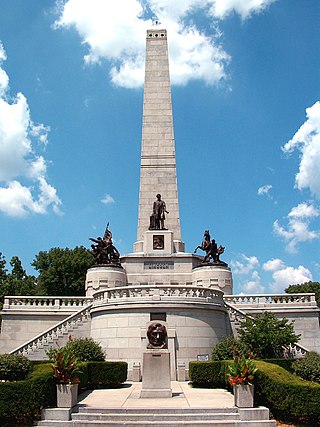
The Lincoln Tomb is the final resting place of Abraham Lincoln, the 16th president of the United States; his wife Mary Todd Lincoln; and three of their four sons: Edward, William, and Thomas. It is located in Oak Ridge Cemetery in Springfield, Illinois.
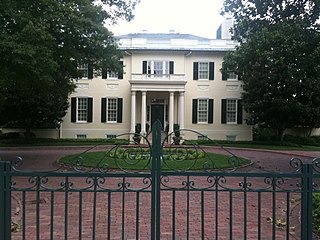
The Virginia Governor's Mansion, better known as the Executive Mansion, is located in Richmond, Virginia, on Capitol Square and serves as the official residence of the governor of the Commonwealth of Virginia. Designed by Alexander Parris, it is the oldest occupied governor's mansion in the United States. It has served as the home of Virginia governors and their families since 1813. This mansion is both a Virginia and a National Historic Landmark and has had a number of renovations and expansions during the 20th century.

Laurel Hill Cemetery, also called Laurel Hill East to distinguish it from the affiliated West Laurel Hill Cemetery in Bala Cynwyd, is a historic rural cemetery in the East Falls neighborhood of Philadelphia. Founded in 1836, it was the second major rural cemetery in the United States after Mount Auburn Cemetery in Boston, Massachusetts.
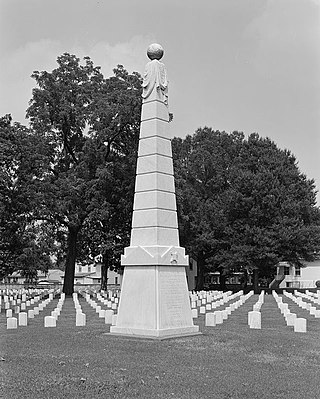
City Point National Cemetery is a United States National Cemetery in the community of City Point within the city of Hopewell, Virginia. Administered by the United States Department of Veterans Affairs, it encompasses 6.7 acres (2.7 ha), and as of the end of 2005, had 6,909 interments. It is managed by Hampton National Cemetery.

Cold Harbor National Cemetery is a United States National Cemetery in Mechanicsville, Hanover County, Virginia. It encompasses 1.4 acres (5,700 m2), and as of the end of 2005, had 2,110 interments. Administered by the United States Department of Veterans Affairs, it is managed by the Hampton National Cemetery.

Winchester National Cemetery is a United States National Cemetery located in the city of Winchester in Frederick County, Virginia. Administered by the United States Department of Veterans Affairs, it encompasses 4.9 acres (2.0 ha), and as of the end of 2005, it had 5,561 interments. It is closed to new interments.

Richmond National Cemetery is a United States National Cemetery three miles (4.8 km) east of Richmond in Henrico County, Virginia. Administered by the United States Department of Veterans Affairs, it encompasses 9.7 acres (3.9 ha), and as of 2021 had more than 11,000 interments. It is closed to new interments. Richmond National Cemetery was listed on the National Register of Historic Places in 1995.
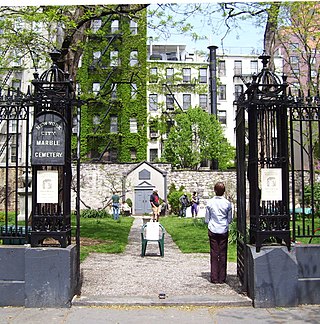
The New York City Marble Cemetery is a historic cemetery founded in 1831, and located at 52-74 East 2nd Street between First and Second Avenues in the East Village neighborhood of Manhattan, New York City. The cemetery has 258 underground burial vaults constructed of Tuckahoe marble on the site.
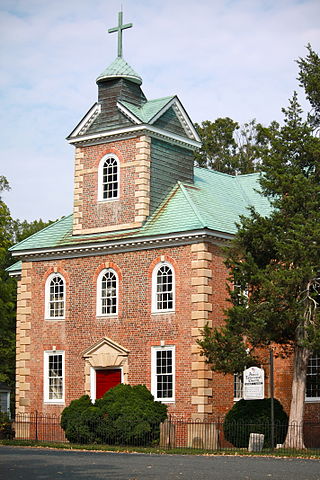
Aquia Church is a historic church and congregation at 2938 Richmond Highway in Stafford, Virginia, USA. It is an Episcopal congregation founded in 1711, that meets in an architecturally exceptional Georgian brick building that was built in the 1750s. The building was designated a National Historic Landmark in 1991 for its architectural importance. It maintains an active congregation with a variety of programs and outreach to the community.
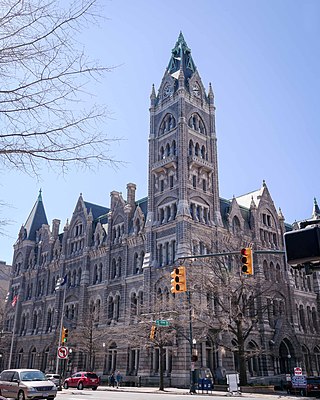
Old City Hall, known formerly as City Hall, is the former city hall of Richmond, Virginia that was designed by Elijah E. Myers. It served as City Hall from its completion in 1894 through the 1970s. The building occupies its own city block in downtown Richmond, bounded by 10th and 11th Streets to the west and east, and Capitol Street and East Broad Street to the south. The building is executed in a meticulous Gothic Revival style, and was designated a National Historic Landmark for its architecture.

The Elbert P. Tuttle U.S. Court of Appeals Building, also known as U.S. Post Office and Courthouse, is a historic Renaissance Revival style courthouse located in the Fairlie-Poplar district of Downtown Atlanta in Fulton County, Georgia. It is the courthouse for the United States Court of Appeals for the Eleventh Circuit.
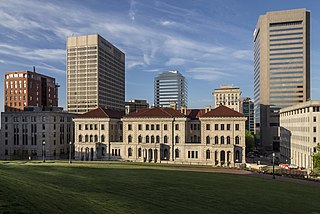
The Lewis F. Powell Jr. United States Courthouse, also known as the U.S. Post Office and Customhouse, is a historic custom house, post office and courthouse located in Richmond, Virginia. Originally constructed in 1858, it was for decades a courthouse for the United States District Court for the Eastern District of Virginia and the United States Court of Appeals for the Fourth Circuit. A new federal district courthouse opened in 2008, but the Powell Courthouse still houses the Fourth Circuit. The United States Congress renamed the building for Supreme Court justice Lewis F. Powell Jr., in 1993. It is listed on the National Register of Historic Places as U.S. Post Office and Customhouse.

The Owen B. Pickett U.S. Custom House is a historic custom house building located at Norfolk, Virginia

The Little Rock U.S. Post Office and Courthouse, also known as Old Post Office and Courthouse, in Little Rock, Arkansas, is a historic post office, federal office, and courthouse building located at Little Rock in Pulaski County, Arkansas. It is a courthouse for the United States District Court for the Eastern District of Arkansas.

The Bridge at Falling Creek is a historic stone arch bridge located near Richmond, in Chesterfield County, Virginia. It was built about 1823 of rough-cut, uncoursed granite. It is carried by two semicircular barrel arches with voussoirs of rough-finished granite. Its width including parapets is 24 feet (7.3 m), and its length is 148 feet (45 m). It carried the southbound lanes of U.S. Route 301 until 1977, when it was put out of service. It is accessible from a wayside that includes the Falling Creek UDC Jefferson Davis Highway Marker. The bridge was partially damaged in 2004 but still remains significant. It was listed on the National Register of Historic Places in 1995.
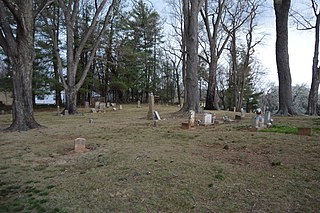
Daughters of Zion Cemetery, also known as Zion Cemetery, Society Cemetery, and Old Oakwood Section, is a historic African-American cemetery located at Charlottesville, Virginia, United States. It was established in 1873, and contains an estimated 300 burial sites with 152 of the burials commemorated with 136 surviving grave markers. It consists exclusively of marble and granite grave markers with a single 20 foot by 20 foot section enclosed with a cast-iron fence. Notable burials include Benjamin Tonsler (1854–1917), who built the Benjamin Tonsler House. The city assumed title to the property in the 1970s, and the last burial occurred in 1995.
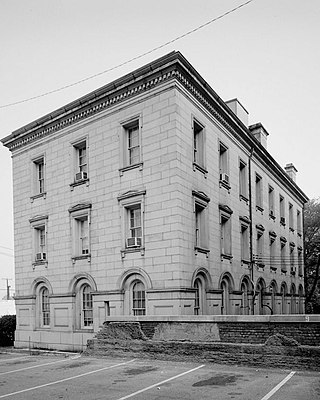
Petersburg City Hall is a historic city hall building located at Petersburg, Virginia. It was designed by architect Ammi B. Young and built between 1856 and 1859, as the U.S. Customs House and Post Office.

Scott House, also known as Frederic W. Scott House and Scott-Bocock House, is a historic home located in Richmond, Virginia and is owned by Virginia Commonwealth University as the University's alumni house. The first floor of the historic house is available for university, community and corporate events. Many affairs — including university and alumni receptions and retreats — have occurred at the Scott House since its doors opened in the fall of 2004.

New Pump-House, also known as the Byrd Park Pump House, is a historic pumping station building located in Byrd Park, Richmond, Virginia. It was built in 1881–1883, and is a three-part, "I" plan, Gothic Revival style granite building. A one-story, L-shaped annex was built in 1905. The building features a steeply pitched roof, projecting gables, Gothic arches, and lancet windows. Also on the property are the contributing Beaux Arts style 1924 Hydro Electric Pumping Station constructed of brick, concrete, and stucco and the 1881 Worthington Steam Pump Building, a one-story Italianate style pump house built of brick coated with stucco. The complex was built as the waterworks for the city of Richmond.

























